By Mary Hui

A new crop of symbols has emerged in Hong Kong’s protests in recent weeks: swastikas and the term “Chinazi.”
At a demonstration earlier this month, when protesters marched to the US consulate to urge Congress to pass the Hong Kong Human Rights and Democracy Act, a red flag with yellow stars arranged in the shape of a swastika was hung from a bridge, as the flags of Hong Kong and China fluttered overhead.

The Chinazi flag flying over a large crowd of protesters.
At another major march a week later (Sep. 15), one of the most widely seen posters was that of the “Chinazi” flag.

A new crop of symbols has emerged in Hong Kong’s protests in recent weeks: swastikas and the term “Chinazi.”
At a demonstration earlier this month, when protesters marched to the US consulate to urge Congress to pass the Hong Kong Human Rights and Democracy Act, a red flag with yellow stars arranged in the shape of a swastika was hung from a bridge, as the flags of Hong Kong and China fluttered overhead.

The Chinazi flag flying over a large crowd of protesters.
At another major march a week later (Sep. 15), one of the most widely seen posters was that of the “Chinazi” flag.
Local pro-democracy party People Power also set up a small stage at the start of the march, putting up a banner that cast chief executive Carrie Lam as an unmistakable Hitler, giving her a the label “Butcher Carrie” against a backdrop of yellow swastikas.

Mary Hui
✔@maryhui
· Sep 15, 2019
This guy's writing calligraphy. He just wrote one that says 良知—conscience. The flyers are free to take.
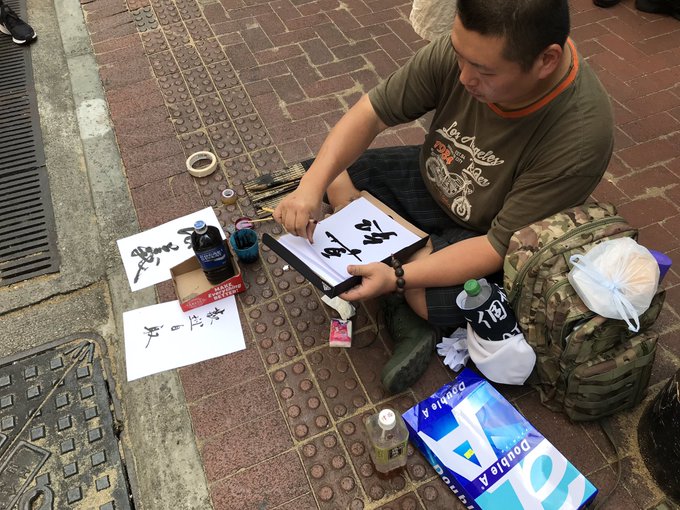

Mary Hui
✔@maryhui
Banner by People Power, the pro-democracy coalition chaired by lawmaker Ray Chan.
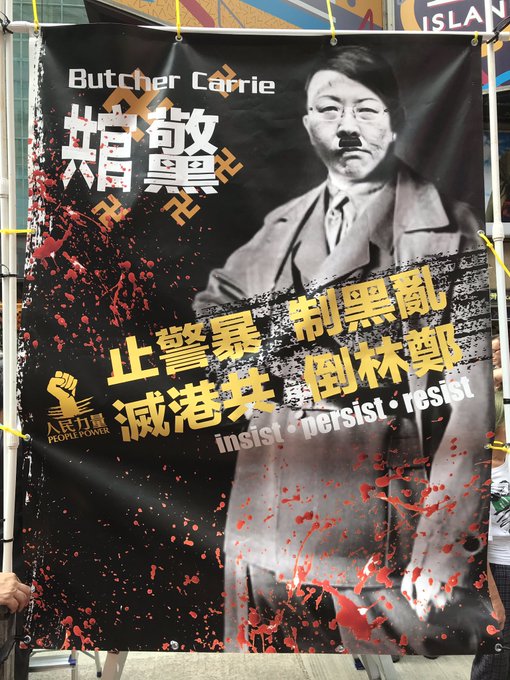
23
9:15 AM - Sep 15, 2019
And this Sunday (Sep. 29)—coinciding with the 80th anniversary of the divvying up of occupied Poland between Germany and the Soviet Union—Hong Kongers are scheduled to host a large protest, alternately dubbed the “Global Anti-Totalitarianism March” and the “Global Anti-Chinazi March,” alongside dozens of cities around the world.

Mary Hui
✔@maryhui
· Sep 15, 2019
This guy's writing calligraphy. He just wrote one that says 良知—conscience. The flyers are free to take.


Mary Hui
✔@maryhui
Banner by People Power, the pro-democracy coalition chaired by lawmaker Ray Chan.

23
9:15 AM - Sep 15, 2019
And this Sunday (Sep. 29)—coinciding with the 80th anniversary of the divvying up of occupied Poland between Germany and the Soviet Union—Hong Kongers are scheduled to host a large protest, alternately dubbed the “Global Anti-Totalitarianism March” and the “Global Anti-Chinazi March,” alongside dozens of cities around the world.
Ahead of the march, organizers have shared a series of graphics on the event’s Telegram channel to explain the term “Chinazi,” drawing comparisons between, for example, the Holocaust’s concentration camps and China’s concentration camps in East Turkestan.
Making comparisons to Nazi Germany and the Holocaust has long been a sensitive issue.
Making comparisons to Nazi Germany and the Holocaust has long been a sensitive issue.
Adolf Hitler and the Nazis committed one of the worst atrocities ever in human history, orchestrating a state-sponsored genocide that led to the murder of millions of Jews.
Comparing China to Nazi Germany in fact predates Hong Kong’s protests, and traces its roots back to anti-China protests in Hanoi and Tokyo in 2011 and 2012.

First use of the term "Chinazi": Vietnamese protesters showed a banner depicting the late Chinese revolutionary leader Mao Zedong and Nazi dictator Adolf Hitler to compare China to the Nazis during an anti-China rally in Hanoi, Vietnam, on Aug. 21, 2011.
Japanese people condemned Chinazism at a rally in Tokyo in September 2012.
Writing in the Times of Israel newspaper, Deborah Fripp, president of the Teach the Shoah Foundation, noted that “a well-placed comparison to the Holocaust can be a call-to-action, can help to highlight bias and create change.”
In August, for example, an Australian lawmaker compared the West’s approach to China to France’s failure to hold back Nazi Germany.
Hong Kong protesters see the Nazi comparisons as necessary.
One protester who identified himself as Johnson, and who is an administrator in the public Telegram group for Sunday’s “anti-Chinazi march” said in an interview conducted over the messaging app that he understood concerns over the use of the term “Chinazi,” but that “the atrocities committed by the [Chinese Communist Party] are greater than you originally thought of.”
“Making this term ‘Chinazi’ is to send a warning to the world: if we do not stop the CCP (Chinese Communist Party), the deaths and the tragedies will probably keep happening,” he said.
“Making this term ‘Chinazi’ is to send a warning to the world: if we do not stop the CCP (Chinese Communist Party), the deaths and the tragedies will probably keep happening,” he said.
“The victims may not only be the Chinese people, the Hongkongers, the Taiwanese, but may be you. The history of German Nazi may repeat itself.”
As of today (Sept. 26), Nazi imagery was still being deployed, with material featuring swastikas, the Chinazi term, and comparisons between China and the Holocaust still being shared on Telegram groups.
As of today (Sept. 26), Nazi imagery was still being deployed, with material featuring swastikas, the Chinazi term, and comparisons between China and the Holocaust still being shared on Telegram groups.
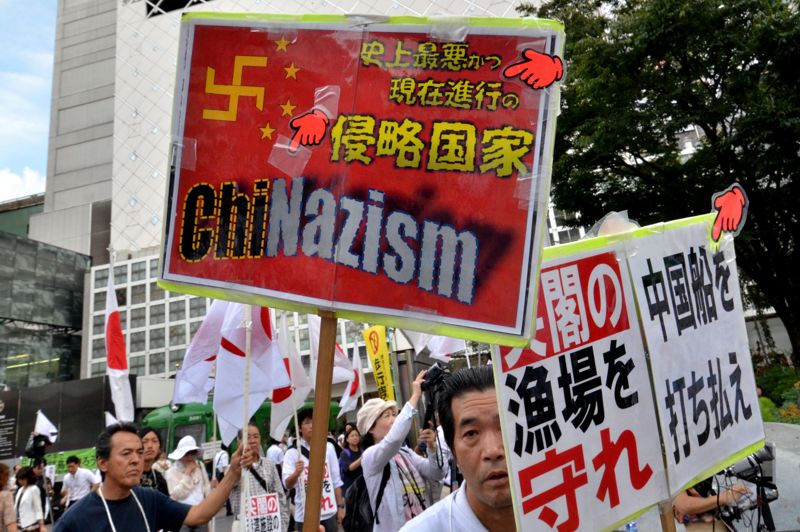
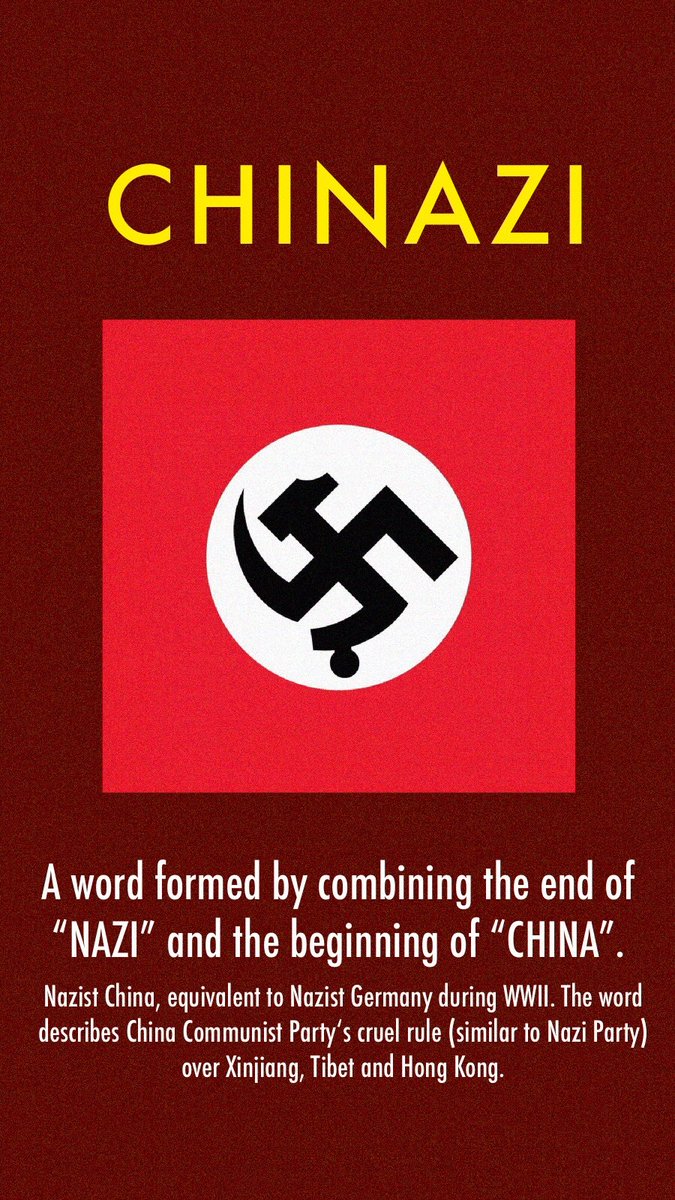
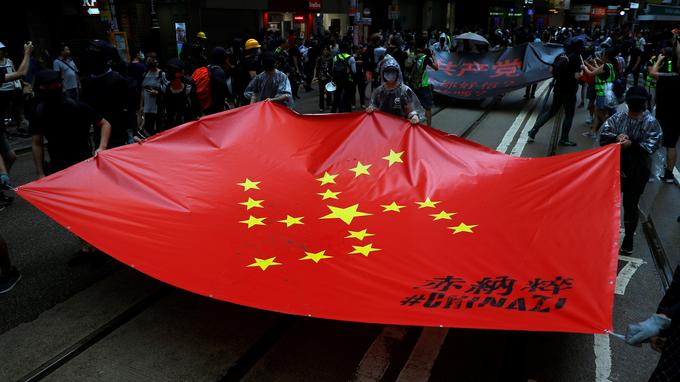
Aucun commentaire:
Enregistrer un commentaire